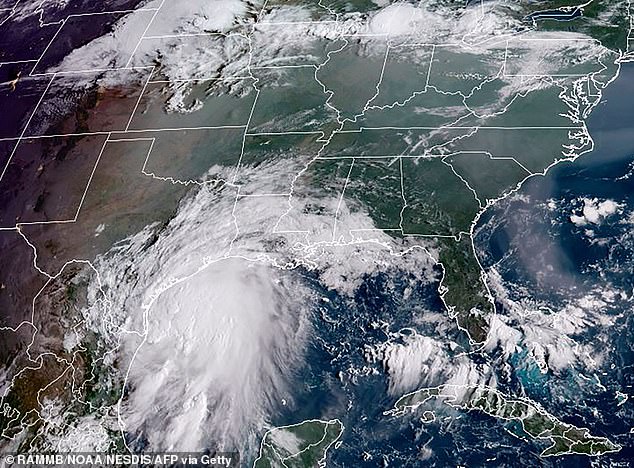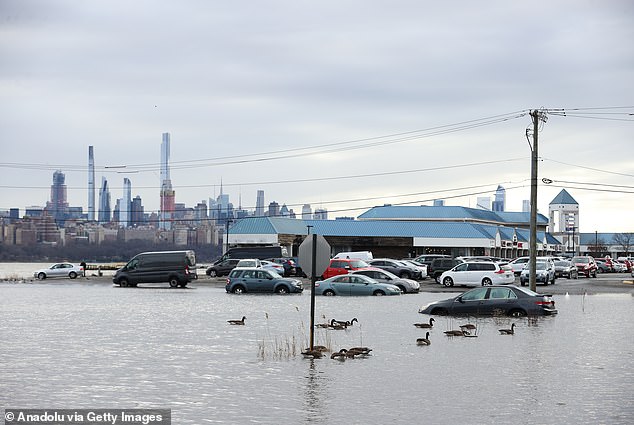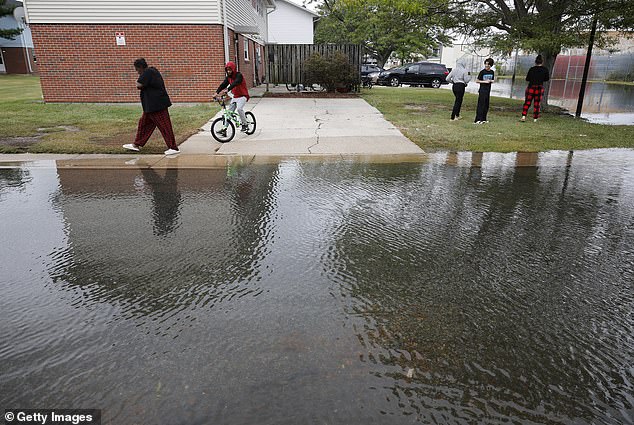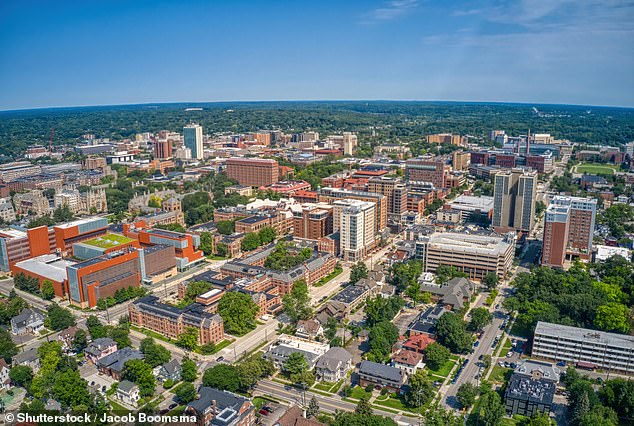Map shows the FIVE coastal states facing the worst flooding – and the schools and hospitals that will be underwater by 2050
The 90 million people living along the American coast have been put on alert.
Sea levels are rising, storms are becoming more intense and more and more houses, schools and hospitals are being flooded.
That is the message of a shocking new report from the Union of Concerned Scientists.
According to their 20-page study, rising tides will expose more than 1,600 pieces of infrastructure to flooding at least twice a year by mid-century.
And the southern coastal state of Louisiana is in the eye of the storm.
The Union of Concerned Scientists says 334 key locations in Louisiana will experience frequent flooding by mid-century

A motorist navigates a flooded intersection after heavy rains in Crisfield, Maryland, one of the states most at risk from coastal flooding.
Researchers have found that the Pelican State could lose as many as 334 key locations to flooding by 2050.
This amounts to 189 low-cost homes, a dozen government offices, 23 schools, 41 health centres, 38 energy installations and 31 sewage treatment plants.

Rachel Cleetus says it’s time to take action on flooding
New Jersey is not far behind: the state of New Jersey is on track to lose 304 such buildings along its 130 miles (209 kilometers) of Atlantic coastline.
Florida, Maryland and California are among the five states in the country most at risk.
Rachel Cleetus, policy director for the research group, said the report is a wake-up call for “millions of people in coastal communities”.
“Policymakers and public and private decision-makers must now take urgent protective measures,” Cleetus said.
The report comes as Tropical Storm Debby continues to wrought devastating rain, wind and floodwaters across the US East Coast.
The hurricane made landfall on Florida’s Gulf Coast on Monday, killing at least six people and leaving 350,000 homes without power.
The storm moved into Georgia and the Carolinas overnight, threatening to drop historic amounts of rain and create dangerous ocean waves.
Climate experts warn that storms like Debby will become more frequent and more intense in a warming world.
This new report shows that flooding due to rising sea levels is getting worse, even without such events receiving much media attention.
Since 2000, chronic tidal flooding, also known as sunny-day flooding, has increased by 400 percent in the U.S. Southeast Atlantic Ocean, researchers found.
Along the Gulf Coast, that percentage was as high as 1,100 percent.
Currently, there are approximately 900 “critical infrastructure” locations along the U.S. coastline that are at risk of high-tide flooding at least twice a year.
These included schools, hospitals, power plants, clinics and sewage treatment plants.
But by mid-century, that number will rise to 1,600, affecting about 3 million people.
In the longer term, the amount of infrastructure regularly exposed to flooding could increase further.

A satellite image of a tropical storm off the coast of the US state of Texas

High water stranded cars and left residents unable to leave their homes in Edgewater, New Jersey, earlier this year. The Garden State is poised to experience worse flooding in the coming decades.
Researchers predicted a worst-case scenario in which sea levels would have risen by 1.80 meters by the end of the century.
This would mean that as many as 15,000 locations would be exposed to tidal flooding.
In addition to schools and hospitals, the researchers also looked at wastewater treatment plants, government buildings and fire stations.
Also on the list were vacant lots, where residents could be exposed to pollutants in the event of a flood.
The projects also included social housing complexes and subsidized apartment complexes.
More than 40 percent of the approximately 150,000 assets the researchers examined for the report are social or subsidized housing.
That’s a frightening number for a country that already has a shortage of some 7 million cheap units.
Researchers showed how coastal communities have already had their lives turned upside down by flooding.
Starting in 2020, some 4,200 residents of Tidewater Gardens in Norfolk, Virginia, were forced to leave their homes when the government razed their affordable housing complex to make way for a billion-dollar coastal protection plan.
According to researchers, many of them had difficulty finding a new home.
In Charleston, South Carolina, sewer overflows from tidal wave flooding have caused dangerous untreated sewage to spill into nearby waterways.
And in Miami, Florida, developers continue to spend billions on new apartments even though they are located in devastated flood zones, researchers say.
The report is alarming for people who have bought homes along the coastline, where flooding is becoming more common.
They have to pay higher insurance premiums and in some cases they are just one flood away from damaging their home or having it dramatically reduced in value.
Home buyers in the U.S. face tough choices: where to buy a home? And how to survive the increasingly frequent wildfires, floods and other natural disasters that could destroy their prized possessions.
According to a survey by Forbes Home, nearly a third of Americans cite global warming as a reason for moving.

Neighbors survey flooded streets outside their apartments after two days of heavy rain from a tropical storm in Crisfield, Maryland

Climate change is forcing people to adapt their lifestyles — including moving to new cities — but not every city is worth packing your life for. Ann Arbor (pictured) has seen its cost of living rise six percent above the national average and an astonishing 17 percent above Michigan’s average
Many cities have therefore enthusiastically added ‘climate paradise’ to their list of attractions to attract new home buyers.
Places like Duluth, Minnesota, Ann Arbor, Michigan, and Burlington, Vermont are considered “climate havens,” meaning they are good places to live as the Earth continues to warm.
But as with all sustainable businesses, making greener choices usually comes with a higher price tag, and Americans are already suffering under the heavy burden of inflation.
But as global warming increases the likelihood of more natural disasters, such as hurricanes in Florida, wildfires in California and unbearable heat in Texas, many Americans are being forced to leave their cities and move to places with better weather.
According to Go Banking Rates, the cost of living in Ann Arbor has increased six percent above the national average and a whopping 17 percent above the Michigan average.
According to Zillow, the average home in the Midwestern city costs more than $520,000, compared to the U.S. average rate of $363,000.
Madison, Wisconsin, isn’t faring much better when it comes to saving Americans money, as health care costs rose 24 percent and utility prices rose 9 percent, according to Go Banking Rates.
However, home prices are only $30,000 higher than average.
The cost of living in Burlington is sky-high, making any American cry, at 24 percent higher than the national average.
Even within its own state, the city is 19 percent more expensive, with home prices on par with Ann Arbor.
But not all climate havens are bad for the wallet: In Duluth, the cost of living is eight percent lower than the national average, and in Minnesota it’s two percent lower.
Another place in Minnesota that is a good investment is Minneapolis, where both the cost of living and home prices are lower than the national average, according to Go Banking Rates.
If the Midwest isn’t your thing, Buffalo, New York, is also a great option, with a cost of living five percent lower than the national average, the outlet reported. Utilities and groceries tend to be cheaper here, too.
